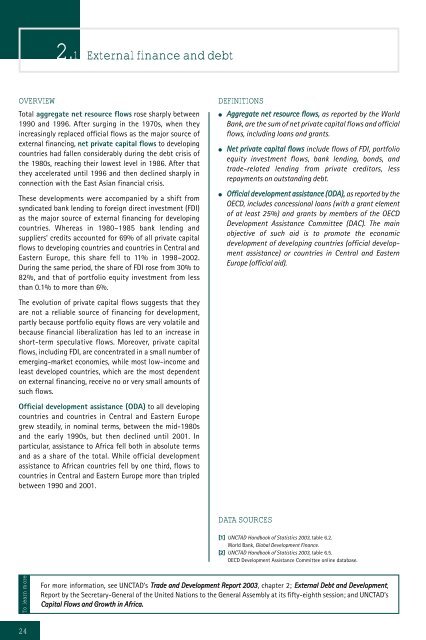Development and Globalization: - Unctad
Development and Globalization: - Unctad
Development and Globalization: - Unctad
Create successful ePaper yourself
Turn your PDF publications into a flip-book with our unique Google optimized e-Paper software.
OVERVIEW DEFINITIONS<br />
Total aggregate net resource flows rose sharply between<br />
1990 <strong>and</strong> 1996. After surging in the 1970s, when they<br />
increasingly replaced official flows as the major source of<br />
external financing, net private capital flows to developing<br />
countries had fallen considerably during the debt crisis of<br />
the 1980s, reaching their lowest level in 1986. After that<br />
they accelerated until 1996 <strong>and</strong> then declined sharply in<br />
connection with the East Asian financial crisis.<br />
These developments were accompanied by a shift from<br />
syndicated bank lending to foreign direct investment (FDI)<br />
as the major source of external financing for developing<br />
countries. Whereas in 1980–1985 bank lending <strong>and</strong><br />
suppliers’ credits accounted for 69% of all private capital<br />
flows to developing countries <strong>and</strong> countries in Central <strong>and</strong><br />
Eastern Europe, this share fell to 11% in 1998–2002.<br />
During the same period, the share of FDI rose from 30% to<br />
82%, <strong>and</strong> that of portfolio equity investment from less<br />
than 0.1% to more than 6%.<br />
The evolution of private capital flows suggests that they<br />
are not a reliable source of financing for development,<br />
partly because portfolio equity flows are very volatile <strong>and</strong><br />
because financial liberalization has led to an increase in<br />
short-term speculative flows. Moreover, private capital<br />
flows, including FDI, are concentrated in a small number of<br />
emerging-market economies, while most low-income <strong>and</strong><br />
least developed countries, which are the most dependent<br />
on external financing, receive no or very small amounts of<br />
such flows.<br />
Official development assistance (ODA) to all developing<br />
countries <strong>and</strong> countries in Central <strong>and</strong> Eastern Europe<br />
grew steadily, in nominal terms, between the mid-1980s<br />
<strong>and</strong> the early 1990s, but then declined until 2001. In<br />
particular, assistance to Africa fell both in absolute terms<br />
<strong>and</strong> as a share of the total. While official development<br />
assistance to African countries fell by one third, flows to<br />
countries in Central <strong>and</strong> Eastern Europe more than tripled<br />
between 1990 <strong>and</strong> 2001.<br />
To learn more<br />
24<br />
2.1 External finance <strong>and</strong> debt<br />
● Aggregate net resource flows, as reported by the World<br />
Bank, are the sum of net private capital flows <strong>and</strong> official<br />
flows, including loans <strong>and</strong> grants.<br />
● Net private capital flows include flows of FDI, portfolio<br />
equity investment flows, bank lending, bonds, <strong>and</strong><br />
trade-related lending from private creditors, less<br />
repayments on outst<strong>and</strong>ing debt.<br />
● Official development assistance (ODA), as reported by the<br />
OECD, includes concessional loans (with a grant element<br />
of at least 25%) <strong>and</strong> grants by members of the OECD<br />
<strong>Development</strong> Assistance Committee (DAC). The main<br />
objective of such aid is to promote the economic<br />
development of developing countries (official development<br />
assistance) or countries in Central <strong>and</strong> Eastern<br />
Europe (official aid).<br />
DATA SOURCES<br />
[1] UNCTAD H<strong>and</strong>book of Statistics 2003, table 6.2.<br />
World Bank, Global <strong>Development</strong> Finance.<br />
[2] UNCTAD H<strong>and</strong>book of Statistics 2003, table 6.5.<br />
OECD <strong>Development</strong> Assistance Committee online database.<br />
For more information, see UNCTAD’s Trade <strong>and</strong> <strong>Development</strong> Report 2003, chapter 2; External Debt <strong>and</strong> <strong>Development</strong>,<br />
Report by the Secretary-General of the United Nations to the General Assembly at its fifty-eighth session; <strong>and</strong> UNCTAD’s<br />
Capital Flows <strong>and</strong> Growth in Africa.

















